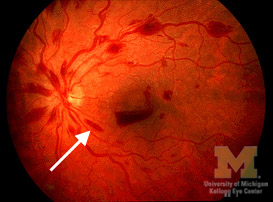Flame hemorrhages
Jump to navigation
Jump to search

|
Diabetic retinopathy Microchapters |
|
Diagnosis |
|---|
|
Treatment |
|
Case Studies |
|
Flame hemorrhages On the Web |
|
American Roentgen Ray Society Images of Flame hemorrhages |
Editor-In-Chief: C. Michael Gibson, M.S., M.D. [1]
Overview
Flame hemorrhages are flame shaped hemorrhages located in the superficial nerve fiber layer of the retina that appear dark dark red on fundoscopic examination.
Pathophysiology
Flame hemorrhages are caused by leakage from arterioles due to ischemic damage or from veins that are ischemic or in under high pressure.
References
External links
- Diabetic Retinopathy Resource Guide from the National Eye Institute (NEI).
- National Diabetes Information Clearinghouse